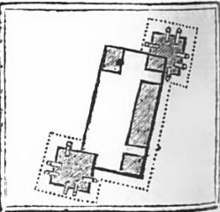Fort Western
Fort Western is a former British colonial outpost at the head of navigation on the Kennebec River at modern Augusta, Maine, United States. It was built in 1754 during the French and Indian War, and is now a National Historic Landmark and local historic site owned by the city. Its main building, the only original element of the fort to survive, was restored in 1920 and now depicts its original use as a trading post.
Fort Western | |
.jpg) Fort Western in 1936 | |
  | |
| Location | Bowman Street, Augusta, Maine |
|---|---|
| Coordinates | 44°18′59″N 69°46′16″W |
| Area | less than one acre |
| Built | 1754 |
| Architect | Gershom Flagg |
| NRHP reference No. | 69000009 |
| Significant dates | |
| Added to NRHP | December 2, 1969[1] |
| Designated NHL | November 7, 1973[2] |
French and Indian War

Fort Western was built by a Boston land company (the Kennebec Proprietors) in 1754 as a fortified trading post, and to promote settlement in the area. The fort was a log palisade with blockhouses which protected a store and warehouse. It was never directly attacked. From a high elevation a large rectangular enclosure commanded the river for more than a mile. Blockhouses 24 feet square and watch-boxes 12 feet square guarded opposite corners, and within stood a two-story main house 100 by 32 feet (30.5 m × 9.8 m). After the war ended, James Howard, its last commander, purchased the fort and operated the trading post.[3]
American Revolution
After 1769, Fort Western fell into decay. In 1775, Benedict Arnold's expedition to Quebec stopped at Fort Western long enough to repair bateaux. Arnold, Daniel Morgan, Roger Enos, and Aaron Burr stayed as guests in the garrison while their force camped outside. Fort Western was the starting point for the march through the wilderness to Quebec.
Old Fort Western
The main building of the fort eventually passed out of the Howard family, and was converted into a tenement house. It was repurchased in Howard family descendants in 1919, and restored the following year, which included the construction of two new blockhouses and a stockade. The stockade was again rebuilt in 1960.[3] Today its main building is a little-altered example of an 18th-century trading post. The fort and store are maintained as a museum and are open to the public during the summer months.
The fort was listed on the National Register of Historic Places in 1969, and was declared a National Historic Landmark in 1973.[2][3]
See also
References
- "National Register Information System". National Register of Historic Places. National Park Service. January 23, 2007.
- "Fort Western". National Historic Landmark summary listing. National Park Service. Archived from the original on 2010-09-23. Retrieved 2008-05-14.
- Charles Snell (1972). "National Register of Historic Places Inventory-Nomination: Fort Western" (PDF). National Park Service. Retrieved 2009-06-22. Cite journal requires
|journal=(help) and Accompanying two photos, exterior, from 1971 (484 KB)